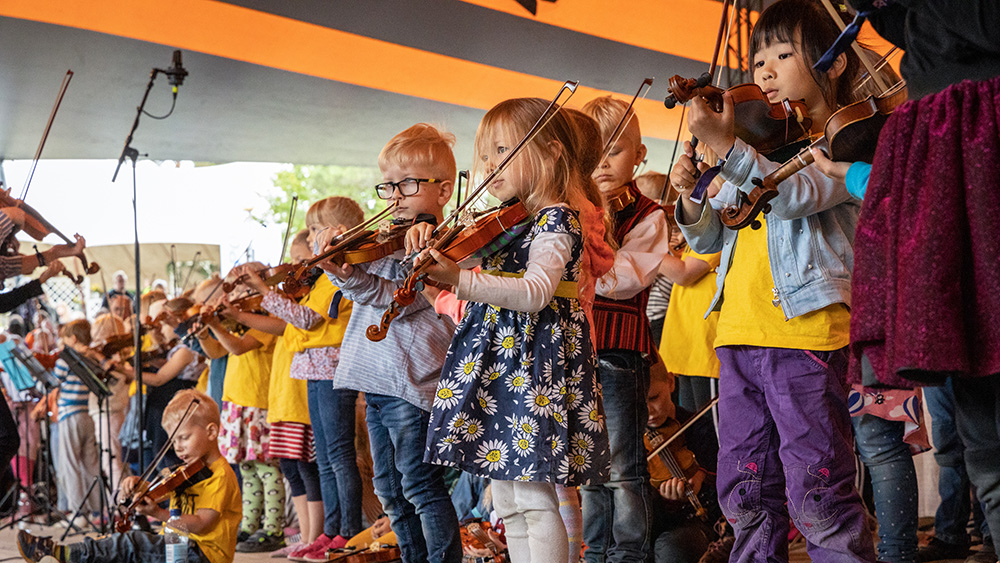Kaustinen folk fiddle playing and Nordic clinker boat tradition inscribed to UNESCO List of Intangible Cultural Heritage

UNESCO’s Intergovernmental Committee has inscribed Kaustinen folk fiddle playing to its Representative List of Intangible Cultural Heritage of Humanity at its currently ongoing meeting in Paris on December 15. The Nordic clinker boat tradition, which Finland proposed for inscription together with the other Nordic countries, was also inscribed. Currently, UNESCO’s lists of intangible cultural heritage include more than 600 elements from around the world. In Finland, the Ministry of Education and Culture is in charge of matters related to intangible cultural heritage and the Finnish Heritage Agency is responsible for implementing the Convention and coordinating the application processes.
Finland’s first element on the lists is the sauna culture, which was inscribed in December 2020. Now, the list will be complemented with Kaustinen fiddle playing.
Hundreds of people in the small town of Kaustinen play the Kaustinen fiddle and engage in activities related to it. One important reason why this tradition has been so successfully passed on from generation to generation is the internationally acclaimed method of näppäri pedagogics. These days, the Kaustinen Folk Music Festival is the most important Finnish folk music festival. More than 4,000 performers, both professionals and amateurs, participate in the event every year.
Finland is also a partner in an inscription concerning Nordic clinker boat tradition. Clinker boats have been used in the north for thousands of years, and they have been very important to maritime transport in all the Nordic countries. To this day, hundreds of thousands of these wooden boats can be found on the shores of Finland, where they are used for fishing, sailing and rowing. However, these days Finland only has around 50 professional boat builders.
This multinational tradition was inscribed to the list at the Paris meeting on December 14 2021. The Pan-Nordic application process was coordinated by Norway, and the participants included all of the Nordic countries, as well as Åland and Faroe Islands.
- In many ways, intangible cultural heritage is a foundation for our cultures. The UNESCO lists illustrates the great diversity of living heritage. The Kaustinen folk fiddle playing, which is now included on the list, is a perfect example of a living and prosperous cultural heritage in Finland together with our sauna tradition, which was inscribed to the list earlier. Humanity also shares many skills and knowledge. A good example of this is the pan-Nordic clinker boat tradition. I’m delighted to see that people are more interested in intangible cultural heritage and value it more than before, says Minister of Science and Culture Antti Kurvinen.
Background: UNESCO Convention and Lists
Finland ratified the UNESCO Convention for the Safeguarding of the Intangible Cultural Heritage in 2013. In Finland, the Finnish Heritage Agency is responsible for implementing the Convention, and it coordinated both application processes. Reports on the safeguarding of the elements are submitted to UNESCO every six years. The Ministry of Education and Culture is in charge of implementing and reporting on the Convention to UNESCO.
The Convention promotes the safeguarding of intangible cultural heritage and makes people’s, communities’ and groups’ living heritage more visible. Intangible cultural heritage may include for example performing arts, craft skills, oral traditions, social customs or knowledge, skills and practices related to nature and the universe.
As part of the Convention, living heritage is inventoried both at a national and a global level. UNESCO maintains two intangible cultural heritage lists and a register of good practices. The aim of the lists is to increase the visibility of living heritage and share good practices between countries. By the time of the currently ongoing UNESCO meeting, the lists contained a total of 584 items from 131 countries. A further 60 applications are being processed this year. In Finland, examples of living heritage are collected on the Wiki-Inventory for Living Heritage.
Inquiries:
- Mirva Mattila, Senior Ministerial Adviser, [email protected], tel. + 358 0295 330269
- Leena Marsio, Senior Adviser, Finnish Heritage Agency, [email protected], tel. 029533 6017
- Other news about intangible cultural heritage (Finnish Heritage Agency)
- More information on intangible cultural heritage (Finnish Heritage Agency)
- Material for the media